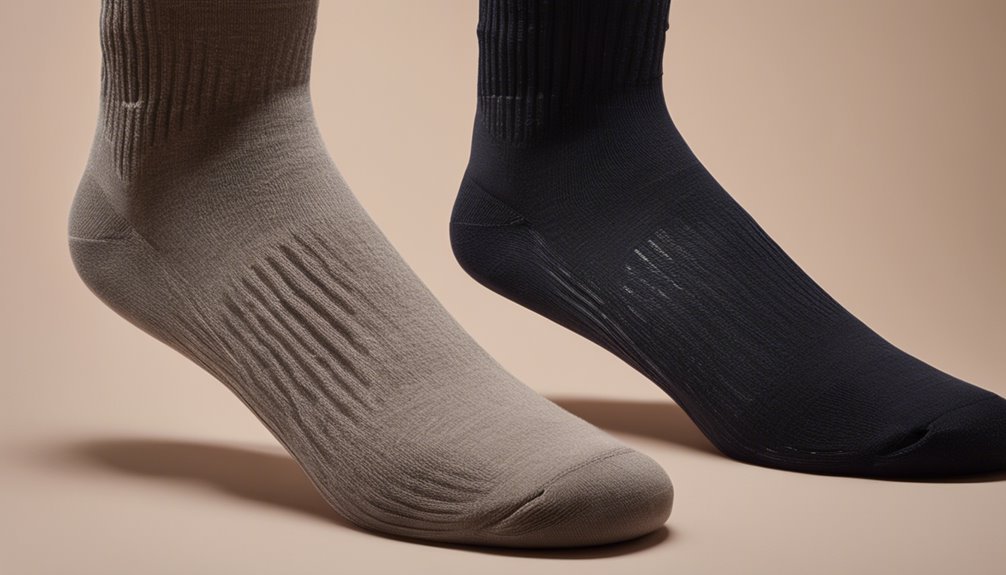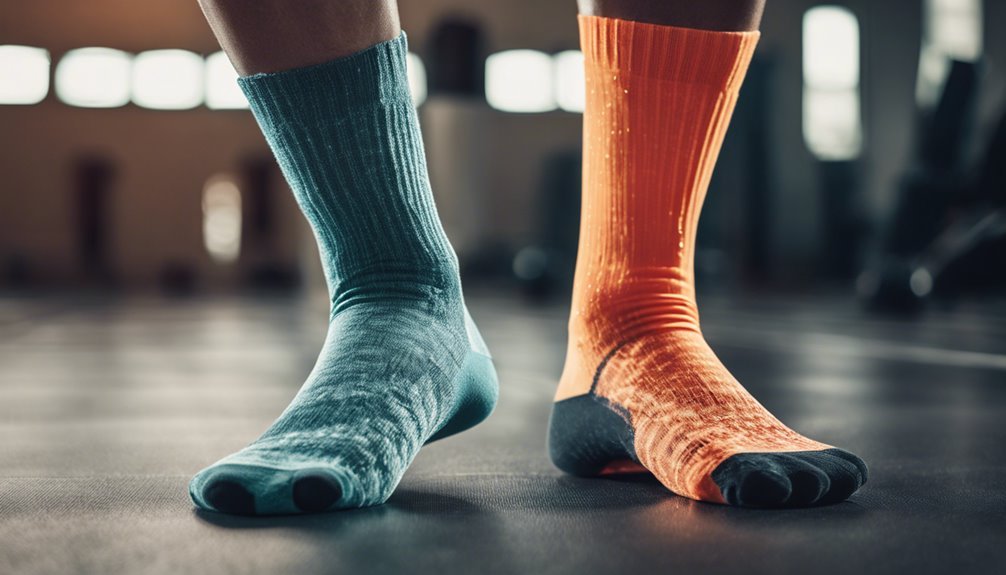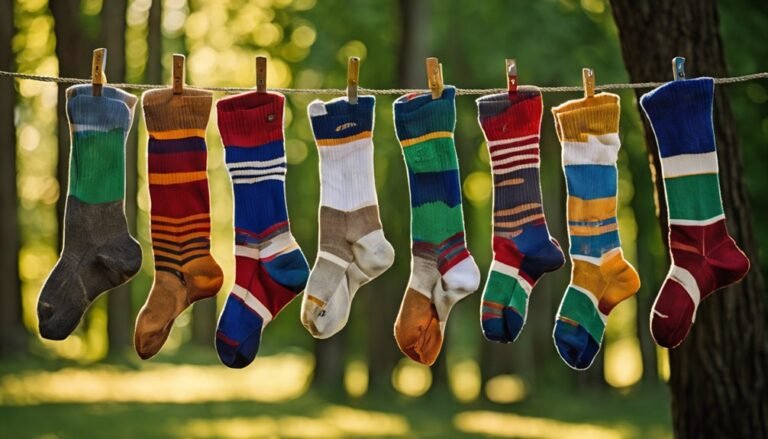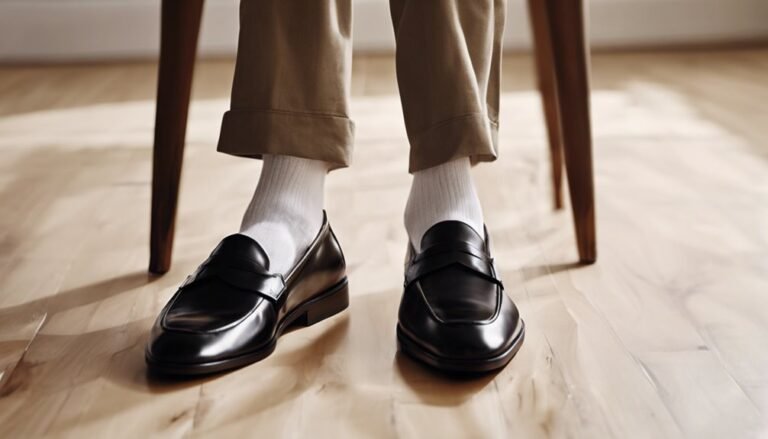Gym Socks vs. Running Socks: Which Absorbs Sweat Better?
When it comes to absorbing sweat, running socks typically outperform gym socks thanks to advanced moisture-wicking technologies and strategic ventilation. Running socks often feature materials like polyester and nylon, designed for breathability and quick moisture evaporation. Gym socks, while supportive, may focus less on moisture management, which can lead to dampness during intense workouts. Understanding these differences can help you choose the right sock for your activity to enhance comfort and performance. There's more to explore about each type.
Understanding Moisture-Wicking Technology

Moisture-wicking technology is a game-changer for anyone serious about athletic performance, especially when it comes to choosing the right socks. This innovative approach to moisture management focuses on pulling sweat away from your skin, allowing for quicker sweat evaporation. When you're in the zone, the last thing you want is to feel bogged down by damp fabric. Moisture-wicking socks help maintain your foot's ideal temperature, keeping you comfortable and focused on your workout. This technology not only enhances your performance but also reduces the risk of blisters and discomfort. By investing in moisture-wicking socks, you're giving yourself the freedom to push your limits without the distraction of wet feet. It's a simple upgrade that can make a significant difference in your athletic experience.
Key Materials Used in Gym Socks
When choosing gym socks, it's essential to take into account the fabrics that make them effective. Common choices like cotton, polyester, and blends often focus on moisture-wicking technologies and breathability features to keep your feet comfortable during workouts. Understanding these materials can help you select the right pair to enhance your gym experience.
Common Fabric Choices
Choosing the right fabric for gym socks can greatly impact your comfort and performance during workouts. The materials you choose not only affect sock longevity but also influence fabric durability, ensuring your socks withstand rigorous use.
Here are three common fabric choices for gym socks:
- Cotton: While comfortable, it's less durable and absorbs moisture, which can lead to discomfort.
- Polyester: Known for its durability, it offers better moisture management, keeping your feet dry.
- Nylon: This fabric is strong and lightweight, providing excellent stretch and support, enhancing your workout experience.
Moisture-Wicking Technologies
Staying dry during workouts can make a significant difference in your overall performance, and that's where moisture-wicking technologies come into play. These advanced materials enhance moisture absorption and sweat management, keeping your feet comfortable and odor-free.
Here's a quick look at some key materials used in gym socks:
| Material | Benefits |
|---|---|
| Polyester | Quick-drying, lightweight |
| Nylon | Durable, excellent moisture control |
| Merino Wool | Natural temperature regulation |
Breathability Features
While it's essential to keep your feet dry, breathability is equally important for maintaining comfort during workouts. Choosing gym socks that prioritize sock ventilation can greatly enhance your performance. Here are three key materials to look for:
- Merino Wool: Known for excellent moisture absorption, it wicks sweat away while allowing your feet to breathe.
- Nylon: This synthetic fiber offers durability and breathability, helping to regulate temperature during intense sessions.
- Polyester Blends: Often combined with other materials, these blends provide moisture-wicking capabilities while enhancing overall breathability.
Key Materials Used in Running Socks
When you hit the pavement, the materials in your running socks can make all the difference in your comfort and performance. Look for fabrics like merino wool, nylon, and polyester, as they excel in moisture management, helping to wick away sweat and keep your feet dry. This is essential for preventing blisters and maintaining a comfortable stride. Additionally, many running socks offer compression benefits that enhance blood flow, reducing fatigue during those long runs. Socks with a blend of these materials provide both durability and flexibility, allowing for a snug fit without sacrificing breathability. By choosing the right materials, you'll enjoy a more liberating running experience, empowering you to push your limits mile after mile.
Design Features of Gym Socks

Running socks focus heavily on moisture management and performance, but gym socks bring their own unique design features tailored for diverse activities. When you're hitting the gym, you'll appreciate these aspects in your gym socks:
- Ankle Height: Many gym socks come in various ankle heights, offering options that provide support without restricting movement.
- Cushioning Options: Look for socks with varying cushioning levels, designed to absorb impact during high-intensity workouts while keeping your comfort in mind.
- Breathability: Airflow is essential; gym socks often incorporate mesh panels to enhance ventilation and keep your feet cool.
These features make gym socks a versatile choice for everything from weightlifting to yoga, ensuring your feet stay comfortable and dry throughout your workout.
Design Features of Running Socks
Whether you're preparing for a marathon or simply enjoying a jog around the neighborhood, the design features of running socks are essential for optimizing your performance and comfort. These socks prioritize both design aesthetics and functional benefits, ensuring you look good while feeling great. You'll notice seamless construction that reduces friction and the risk of blisters, allowing for a smoother stride. Enhanced arch support and cushioning provide stability, which is vital for longer runs. The moisture-wicking materials keep your feet dry, preventing discomfort during those intense workouts. Additionally, strategic ventilation zones enhance breathability. Ultimately, investing in high-quality running socks means you're not only supporting your feet but also embracing the freedom to run longer and stronger.
Performance in Different Conditions
Although you might not think about it, the performance of your socks can considerably impact your experience in various weather conditions. Whether you're hitting the gym or hitting the pavement, the right socks can make a world of difference. Here are three key factors to take into account regarding sock performance in different activity conditions:
- Humidity: Running socks often have moisture-wicking properties, keeping your feet dry in humid conditions.
- Temperature: Gym socks might retain heat, making them less ideal for hot weather, while lightweight running socks offer breathability.
- Terrain: In rugged environments, specialized running socks provide extra cushioning and support, improving your overall comfort.
Choosing the right pair tailored to your activity conditions is essential for peak sock performance and your overall enjoyment.
The Importance of Fit and Comfort

When it comes to choosing the right socks for your workout, fit and comfort are essential. You need the proper sock size to prevent blisters, while materials that offer breathability and cushioning can enhance your overall experience. With the right combination, you can focus on your performance instead of discomfort.
Proper Sock Size
Finding the right sock size is essential for both comfort and performance during your workouts. A proper fit guarantees that you won't experience blisters or discomfort, allowing you to focus on your routine. Here are three key factors to reflect on:
- Proper Sock Length: Choose a length that suits your activity—ankle, crew, or knee-high—for ideal support.
- Sock Compression: Look for socks that provide the right amount of compression to improve blood flow and reduce fatigue.
- Avoiding Excess Material: A snug fit prevents bunching, which can lead to irritation.
Material and Breathability
Choosing the right sock size is just the beginning; the material and breathability of your socks play a significant role in your overall comfort during workouts. Look for fabrics that enhance sweat management, like moisture-wicking blends, which pull sweat away from your skin, keeping your feet dry and minimizing blisters. Breathable materials, such as mesh panels, promote airflow, ensuring your feet stay cool. Plus, consider sock durability—high-quality materials withstand frequent washing and wear, giving you long-lasting comfort. A well-made sock not only enhances your performance but also supports your freedom to move without restriction. In the end, investing in the right materials will elevate your workout experience, allowing you to focus on your goals instead of discomfort.
Cushioning and Support
Cushioning and support are essential elements that greatly influence your comfort during any workout. The right combination can elevate your performance and keep you injury-free.
When evaluating socks, consider these factors:
- Cushioning Types: Look for options like targeted cushioning for high-impact areas or full cushioning for a plush feel.
- Support Levels: Choose socks with arch support if you need extra stability, especially during long runs or intense gym sessions.
- Fit and Comfort: A snug fit prevents blisters and enhances your overall experience, ensuring your focus stays on your workout.
Making the Right Choice for Your Activity
When it comes to selecting the right socks for your workout, understanding the specific demands of your activity can make all the difference. Your activity preferences and sock longevity should guide your choice. Gym socks often provide cushioning for weightlifting, while running socks are designed for breathability during long runs.
Here's a quick comparison:
| Activity Type | Best Sock Type | Key Features |
|---|---|---|
| Weightlifting | Gym Socks | Cushioning, support |
| Running | Running Socks | Moisture-wicking, lightweight |
| CrossFit | Hybrid Socks | Versatile, durable |
Frequently Asked Questions
Can I Wear Running Socks for Gym Workouts?
Absolutely, you can wear running socks for gym workouts. They offer excellent moisture management, enhancing running performance while guaranteeing sock comfort. Just make certain they fit well to maximize your freedom of movement during various exercises.
How Do I Properly Wash Gym and Running Socks?
Washing your socks is like tending a garden; proper care nurtures longevity. For sock care, use gentle washing techniques—cold water, mild detergent, air dry—and they'll bloom with freshness, ready to support your workouts anew.
Do Thicker Socks Absorb More Sweat?
Thicker socks can enhance sweat absorption, but it really depends on the sock materials. Synthetic fibers often wick moisture better than cotton, so choosing the right blend is key to keeping your feet dry and comfortable.
Are There Socks Specifically for Wet Weather?
Imagine dancing through puddles without a care! Yes, there are socks designed for wet weather, crafted from waterproof materials and breathable fabrics, letting your feet stay dry and comfortable while you embrace the storm around you.
How Often Should I Replace My Gym and Running Socks?
You should replace your gym and running socks every 6-12 months, depending on usage. The sock lifespan can vary considerably based on material impact; synthetic fibers may last longer than cotton, so choose wisely for durability.







